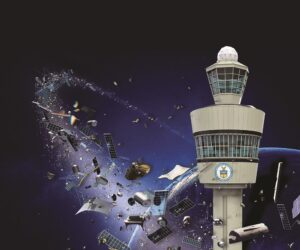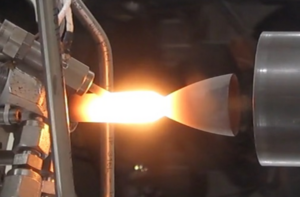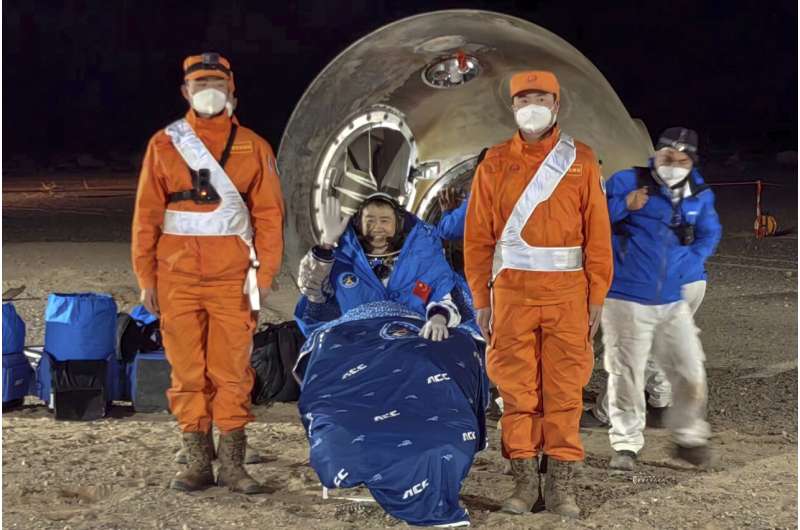E-Space buys RF hardware developer CommAgility
Monday, 05 December 2022 13:26
Greg Wyler’s megaconstellation startup E-Space said Dec. 5 it plans to buy radio frequency module developer CommAgility in a $14.5 million deal.
The post E-Space buys RF hardware developer CommAgility appeared first on SpaceNews.
Growth of SSA systems could create problems for satellite operators
Monday, 05 December 2022 11:30
The growth of space situational awareness (SSA) capabilities worldwide, intended to better track satellites and debris in orbit, could instead create confusion for satellite operators, one official warned.
The post Growth of SSA systems could create problems for satellite operators appeared first on SpaceNews.
Orion set for final Lunar flyby
Monday, 05 December 2022 10:43 Orion performed the second return trajectory correction burn on Sunday, Dec. 4, at 10:43 a.m. CST, using the auxiliary thrusters and increasing the spacecraft's velocity by 1.16 mph (1.71 feet per second).
Shortly after acquiring signal with the Deep Space Network's Canberra ground station at 12:41 a.m. CST, Orion experienced an issue with a power conditioning distribution unit (PCDU), in
Orion performed the second return trajectory correction burn on Sunday, Dec. 4, at 10:43 a.m. CST, using the auxiliary thrusters and increasing the spacecraft's velocity by 1.16 mph (1.71 feet per second).
Shortly after acquiring signal with the Deep Space Network's Canberra ground station at 12:41 a.m. CST, Orion experienced an issue with a power conditioning distribution unit (PCDU), in SpaceX gets federal approval to launch 7,500 communication satellites
Monday, 05 December 2022 10:43 SpaceX, the American aerospace manufacturing company owned by billionaire Elon Musk, has received federal approval to launch 7,500 satellites in an operation that would expand the company's Starlink internet services around the world.
Thursday's decision by the Federal Communications Commission, although not everything SpaceX wanted, was seen as a monumental victory for the company as i
SpaceX, the American aerospace manufacturing company owned by billionaire Elon Musk, has received federal approval to launch 7,500 satellites in an operation that would expand the company's Starlink internet services around the world.
Thursday's decision by the Federal Communications Commission, although not everything SpaceX wanted, was seen as a monumental victory for the company as i AST SpaceMobile closes $75M funding round
Monday, 05 December 2022 10:43 AST SpaceMobile, Inc. (NASDAQ: ASTS) has closed of its offering of 13,636,364 shares of Class A Common Stock raising gross proceeds of $75.0 million. B. Riley Securities ("B. Riley") was the sole book-running manager of the offering. The Company has also granted B. Riley a 30-day option to purchase an additional 2,045,454 shares to cover over-allotments, if any, which would raise an additional $
AST SpaceMobile, Inc. (NASDAQ: ASTS) has closed of its offering of 13,636,364 shares of Class A Common Stock raising gross proceeds of $75.0 million. B. Riley Securities ("B. Riley") was the sole book-running manager of the offering. The Company has also granted B. Riley a 30-day option to purchase an additional 2,045,454 shares to cover over-allotments, if any, which would raise an additional $ China astronauts return from Tiangong space station
Monday, 05 December 2022 10:43 Three Chinese astronauts safely returned to Earth on Sunday after six months aboard the Tiangong space station, state media quoted the country's space agency as saying, with their mission deemed a "complete success."
The team, which had been aboard the station since early June, touched down at the Dongfeng landing site in Inner Mongolia at 8:09 pm Beijing time (1209 GMT), Xinhua news agency
Three Chinese astronauts safely returned to Earth on Sunday after six months aboard the Tiangong space station, state media quoted the country's space agency as saying, with their mission deemed a "complete success."
The team, which had been aboard the station since early June, touched down at the Dongfeng landing site in Inner Mongolia at 8:09 pm Beijing time (1209 GMT), Xinhua news agency Space Force's Wide Field of View achieves First Light
Monday, 05 December 2022 10:43 The United States Space Force Space Systems Command's Wide Field of View Testbed transmitted its "First Light" mission data-product. Performing the satellite's mission operations, Millennium Space Systems, a Boeing (NYSE: BA) company, secured the data beginning October 25.
"Achieving this major milestone is a huge accomplishment, and we are very excited to enter into the calibration phase
The United States Space Force Space Systems Command's Wide Field of View Testbed transmitted its "First Light" mission data-product. Performing the satellite's mission operations, Millennium Space Systems, a Boeing (NYSE: BA) company, secured the data beginning October 25.
"Achieving this major milestone is a huge accomplishment, and we are very excited to enter into the calibration phase Mars set to wink out behind the Moon
Monday, 05 December 2022 10:43 On the night of December 7-8, Mars will be at opposition - opposite the Sun's position in the sky. On that date, Earth is situated directly between Mars and the Sun. The planet is at its brightest, rising as the Sun sets and setting as the Sun rises. Opposition and closest approach to Earth, however, are offset by several days due to the relative shape and orientation of each planet's orbit. Mar
On the night of December 7-8, Mars will be at opposition - opposite the Sun's position in the sky. On that date, Earth is situated directly between Mars and the Sun. The planet is at its brightest, rising as the Sun sets and setting as the Sun rises. Opposition and closest approach to Earth, however, are offset by several days due to the relative shape and orientation of each planet's orbit. Mar The 2022 Geminids meteor shower is approaching
Monday, 05 December 2022 10:43 The cosmos' annual gift to sky watchers, the Geminids Meteor shower, will peak on Dec. 13-14 this year.
During peak activity and perfect weather conditions, which are rare, the Geminids produce approximately 100-150 meteors per hour for viewing. However, this year a wanning gibbous moon will make it harder to view most of the shower, resulting in only 30-40 visible meteors per hour at the
The cosmos' annual gift to sky watchers, the Geminids Meteor shower, will peak on Dec. 13-14 this year.
During peak activity and perfect weather conditions, which are rare, the Geminids produce approximately 100-150 meteors per hour for viewing. However, this year a wanning gibbous moon will make it harder to view most of the shower, resulting in only 30-40 visible meteors per hour at the Flying an interstellar telescope
Monday, 05 December 2022 10:43 Today, he is among the millions of space enthusiasts enjoying the exquisite photography from that instrument that NASA is publishing to give academics as well as armchair astronomers a look back billions of years into the history of the universe.
"It's a little bit of wonder, a little bit of amazement and in some ways, a deep sense of humility having a small role in it," said Peralta, a Ra
Today, he is among the millions of space enthusiasts enjoying the exquisite photography from that instrument that NASA is publishing to give academics as well as armchair astronomers a look back billions of years into the history of the universe.
"It's a little bit of wonder, a little bit of amazement and in some ways, a deep sense of humility having a small role in it," said Peralta, a Ra Researchers observe directly turbulent magnetic reconnection in solar wind
Monday, 05 December 2022 10:43 Researchers from the University of Science and Technology of China (USTC) of the Chinese Academy of Sciences, under the direction of Prof. WANG Rongsheng and Prof. LU Quanming, used data from the Magnetospheric Multiscale (MMS) mission to directly observe bursty and turbulent magnetic reconnection in the solar wind. Their findings were published in Nature Astronomy.
Magnetic reconnection i
Researchers from the University of Science and Technology of China (USTC) of the Chinese Academy of Sciences, under the direction of Prof. WANG Rongsheng and Prof. LU Quanming, used data from the Magnetospheric Multiscale (MMS) mission to directly observe bursty and turbulent magnetic reconnection in the solar wind. Their findings were published in Nature Astronomy.
Magnetic reconnection i Sidus Space receives NOAA Tier 1 License
Monday, 05 December 2022 10:43 Sidus Space, Inc. (NASDAQ:SIDU), a Space-as-a-Service company focused on mission critical hardware manufacturing combined with commercial satellite design, manufacture, launch, and data collection, has secured U.S. regulatory approval to provide global data services from its upcoming LizzieSat-1 mission through a Tier 1 license granted by the National Oceanographic and Atmospheric Administration
Sidus Space, Inc. (NASDAQ:SIDU), a Space-as-a-Service company focused on mission critical hardware manufacturing combined with commercial satellite design, manufacture, launch, and data collection, has secured U.S. regulatory approval to provide global data services from its upcoming LizzieSat-1 mission through a Tier 1 license granted by the National Oceanographic and Atmospheric Administration Dabeeo partners with Maxar to expand the global satellite data analysis market
Monday, 05 December 2022 10:43 Dabeeo, a geospatial information technology company based on AI (CEO: Ju-hum Park), has announced a partnership with Maxar Technology ("Maxar" hereinafter), a leading space technology and intelligence company. This partnership enables Dabeeo to expand its domestic and international earth observation service business.
The satellite data analysis market is expanding rapidly in line with the
Dabeeo, a geospatial information technology company based on AI (CEO: Ju-hum Park), has announced a partnership with Maxar Technology ("Maxar" hereinafter), a leading space technology and intelligence company. This partnership enables Dabeeo to expand its domestic and international earth observation service business.
The satellite data analysis market is expanding rapidly in line with the Chris Pearson takes the reins at Agile Space Industries
Monday, 05 December 2022 09:00
Chris Pearson, former Roccor CEO and Redwire executive vice president, is the new CEO of Durango, Colorado-based propulsion startup Agile Space Industries.
The post Chris Pearson takes the reins at Agile Space Industries appeared first on SpaceNews.
Three Chinese astronauts return to Earth after 6-month mission
Monday, 05 December 2022 07:47

